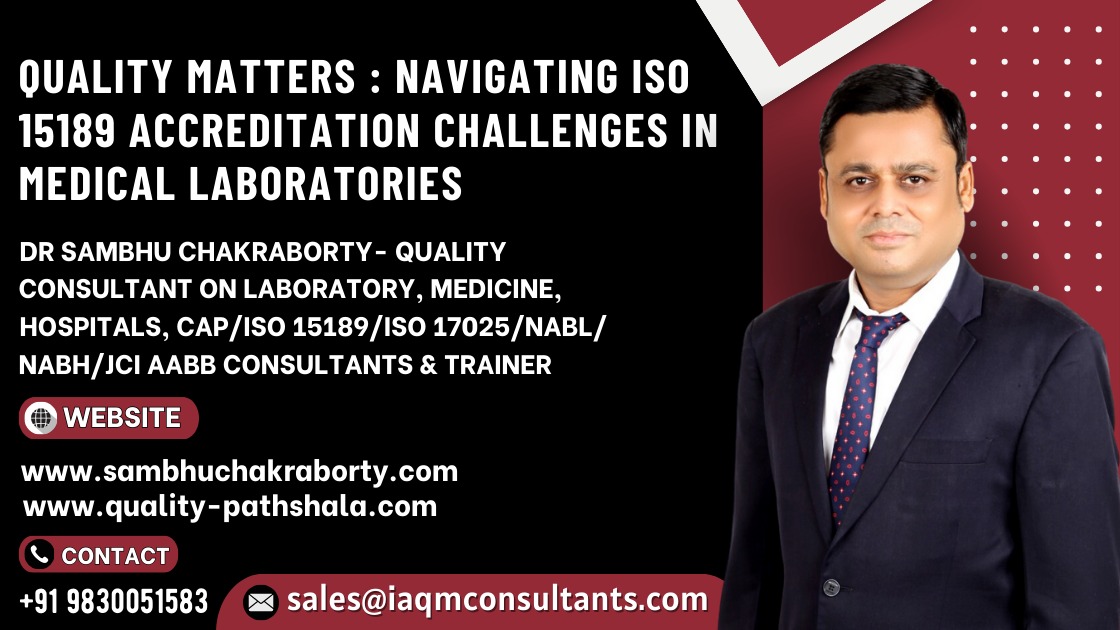Introduction:
Accreditation in the medical laboratory industry is a crucial process that ensures the
quality and reliability of diagnostic services. ISO 15189 is a globally recognized
standard for accreditation, and it comes with its own set of challenges. In this article,
we will delve into the various obstacles faced by medical laboratories in achieving
ISO 15189 accreditation and explore possible solutions.
- Understanding ISO 15189:
One of the primary challenges faced by laboratories is understanding ISO 15189. The
standard is often not presented in a manner that lab professionals can readily
comprehend. It lacks a user-friendly format and can vary in interpretation from person
to person. This ambiguity makes it challenging to implement effectively.
Solution: To address this challenge, laboratories should consider seeking professional
guidance and interpretation of the standard. Engaging experts who can bridge the gap
between technical language and practical application is essential. - Lack of Time and Participation by Lab Consultants:
Many laboratory consultants have multiple commitments, making it difficult for them
to dedicate adequate time to oversee the laboratory quality system. Even when
consultants are present full-time, they may not possess the required training in quality
management, which can hinder their effectiveness.
Solution: Laboratories should invest in training their consultants in quality
management requirements and motivate them to actively participate in accreditation
processes. Allocating dedicated time for quality-related tasks is crucial. - Lack of Adequate Laboratory Consultants in Different Disciplines:
Medical laboratories encompass various disciplines, each with its unique
requirements. The absence of specialized consultants for every discipline can lead to
insufficient supervision and control over pre-analytical, analytical, and post-analytical
functions.
Solution: Laboratories should prioritize the recruitment of specialized consultants in
various disciplines to ensure comprehensive quality management across all areas. - Commercial Viability:
Hiring laboratory consultants can be expensive, and in highly competitive markets,
cost considerations often override investments in quality. The cost of quality is not
always factored into pricing, and users may be reluctant to pay for it.
Solution: Laboratories should educate their clients about the value of accredited
services and the importance of quality. Transparency in pricing and demonstrating the
benefits of accreditation can help overcome this challenge. - Inadequate Manpower:
A shortage of trained and skilled technologists is a common challenge. Low
compensation and multiple job attachments can demotivate staff and compromise the
integrity of testing.
Solution: Laboratories should invest in staff training and development, offer
competitive compensation, and minimize staff workload to ensure the highest level of
quality.
- Cost of Quality Control Materials:
The cost and stability of quality control materials can be prohibitive, making regular
use in laboratories challenging.
Solution: Laboratories should explore cost-effective alternatives and efficient
inventory management practices to reduce the burden of quality control material
expenses. - Quality Control Process:
The absence of evidence-based protocols and differing opinions and interpretations
can lead to confusion and demotivation among staff.
Solution: Laboratories should establish clear, evidence-based protocols and encourage
open communication and feedback to address doubts and concerns. - Calibration and Traceability:
Calibration intervals and traceability can vary, and inadequate information from
machine providers can pose challenges.
Solution: Laboratories should work closely with equipment providers to establish
robust calibration and traceability procedures based on international standards. - Unethical Practices by Referral Clinicians:
Incentives and unethical pricing practices by referral clinicians can compromise the
integrity of laboratory testing.
Solution: Laboratories should maintain strict ethical standards and engage in open
dialogue with referring clinicians to ensure fair and ethical business practices. - Political and Government Pressure:
Political and government pressures can force laboratories to compromise on certain
critical aspects, affecting quality.
Solution: Laboratories should uphold their commitment to quality and transparency,
even in the face of external pressures, and communicate their concerns effectively. - Management Pressure:
Pressure from hospital management to correct mistakes made by physicians can lead
to unethical practices in laboratories.
Solution: Laboratories should establish clear protocols for handling errors and
communicate these protocols to all stakeholders. - Sample Integrity:
Preserving sample integrity is essential, and compromises may occur to avoid
business loss.
Solution: Laboratories should implement strict sample handling and tracking
procedures to ensure sample integrity is maintained at all times. - Management Commitment:
Management’s focus on sales targets and growth development may sometimes
overshadow quality priorities.
Solution: Laboratories should emphasize the importance of quality in achieving long-
term growth and success, aligning management goals with quality objectives.
- Accreditation Board Assessor:
Incompetent assessors can misguide laboratories and burden them with excessive
documentation requirements.
Solution: Laboratories should provide feedback on assessor performance to
accreditation bodies and request competent assessors. - Accreditation Body Commercialization:
Competition between accreditation bodies can lead to compromises in quality
assessment and guidance.
Solution: Laboratories should choose accreditation bodies that prioritize quality over
commercial interests and advocate for standardized accreditation processes.
Conclusion:
Achieving ISO 15189 accreditation in a medical laboratory is a challenging but
necessary endeavour. By recognizing and addressing these challenges, laboratories
can improve the quality of their services, enhance patient safety, and contribute to the
overall advancement of healthcare standards. Transparency, dedication, and a
commitment to excellence are key to overcoming these obstacles and achieving ISO
15189 accreditation successfully.

Thank you sir for this comprehensive guideline to common issues usually faced by us. The clear-cut, to-the-point solution format helps clear many doubts commonly faced while interpreting the ambiguous areas in the ISO guidelines document.
Thank you, Dr. Paripurna Baruah, for your kind words! I’m delighted to hear that the comprehensive guidelines were helpful and cleared up common doubts in interpreting ISO guidelines. Your feedback is truly appreciated. If you have any further questions or topics you’d like covered, feel free to let me know. 🙏📚